12th century
The 12th century is the period from 1101 to 1200 in accordance with the Julian calendar. In the history of European culture, this period is considered part of the High Middle Ages and is sometimes called the Age of the Cistercians. The Golden Age of Islam kept experiencing significant developments, particularly in Islamic Spain, Seljuk and Ghurid territories. Most of the Crusader states including the Kingdom of Jerusalem fell to the Ayyubid dynasty founded by Saladin, who overtook the Fatimids. In Song dynasty of China faced an invasion by Jurchens, which caused a political schism of north and south. The Khmer Empire of Cambodia flourished during this century. Following the expansions of the Ghaznavids and Ghurid Empire, the Muslim conquests in the Indian subcontinent till Bengal began to place in the end of the century.
| Millennium: | 2nd millennium |
|---|---|
| Centuries: | |
| Timelines: | |
| State leaders: | |
| Decades: | |
| Categories: | Births – Deaths Establishments – Disestablishments |
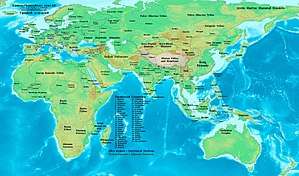
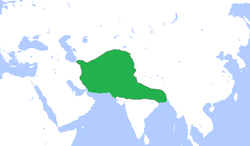
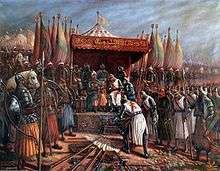


Ongoing events
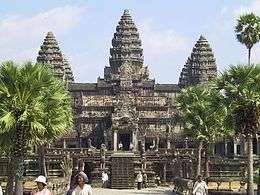
- China is under the Northern Song dynasty. Early in the century, Zhang Zeduan paints Along the River During the Qingming Festival. It will later end up in the Palace Museum, Beijing.
- In southeast Asia, there is conflict between the Khmer Empire and the Champa. Angkor Wat is built under the Hindu king Suryavarman II. By the end of the century the Buddhist Jayavarman VII becomes the ruler.
- Japan is in its Heian period. The Chōjū-jinbutsu-giga is made and attributed to Toba Sōjō. It ends up at the Kōzan-ji, Kyoto.
- In Oceania, the Tuʻi Tonga Empire expands to a much greater area.
- Europe undergoes the Renaissance of the 12th century. The blast furnace for the smelting of cast iron is imported from China, appearing around Lapphyttan, Sweden, as early as 1150.
- Alexander Neckam is the first European to document the mariner's compass, first documented by Shen Kuo during the previous century.
- Christian humanism becomes a self-conscious philosophical tendency in Europe. Christianity is also introduced to Estonia, Finland, and Karelia.
- The first medieval universities are founded. Pierre Abelard teaches.
- Middle English begins to develop, and literacy begins to spread outside the Church throughout Europe.[1] In addition, churchmen are increasingly willing to take on secular roles. By the end of the century, at least a third of England's bishops also act as royal judges in secular matters.[2]
- The Ars antiqua period in the history of the classical music of Western Europe begins.
- The earliest recorded miracle play is performed in Dunstable, England.
- Gothic architecture and trouvère music begin in France.
- During the middle of the century, the Cappella Palatina is built in Palermo, Sicily, and the Madrid Skylitzes manuscript illustrates the Synopsis of Histories by John Skylitzes.
- Fire and plague insurance first become available in Iceland, and the first documented outbreaks of influenza there happens.
- The medieval state of Serbia is formed by Stefan Nemanja and then continued by the Nemanjić dynasty.
- By the end of the century, both the Capetian Dynasty and the House of Anjou are relying primarily on mercenaries in their militaries. Paid soldiers are available year-round, unlike knights who expected certain periods off to maintain their manor lifestyles.[3]
- In India, Hoysala architecture reaches a peak.
- In the Middle East, the icon of Theotokos of Vladimir is painted probably in Constantinople. Everything but the faces will later be retouched, and the icon will go to the Tretyakov Gallery of Moscow.
- The Georgian poet Shota Rustaveli composes his epic poem The Knight in the Panther's Skin.
- Shahab al-Din Suhrawardi founds his "school of illumination".
- In North Africa, the kasbah of Marrakesh is built, including the city gate Bab Agnaou and the Koutoubia mosque.
- In sub-Saharan Africa, Kente cloth is first woven.
- In France, the first piedfort coins in the history of numismatics were minted.
- The city of Tula burns down, marking the end of the Toltec Empire
Inventions, discoveries and introductions by year
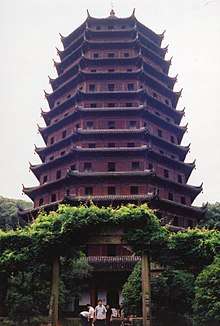
- 1104: The Venice Arsenal of Venice, Italy, is founded. It employed some 16,000 people for the mass production of sailing ships in large assembly lines, hundreds of years before the Industrial Revolution.
- 1106: Finished building of Gelati.
- 1107: The Chinese engineer Wu Deren combines the mechanical compass vehicle of the south-pointing chariot with the distance-measuring odometer device.
- 1111: The Chinese Donglin Academy is founded.
- 1165: The Liuhe Pagoda of Hangzhou, China, is built.
- 1170: The Christian notion of Purgatory is defined.[4]
- 1185: First record of windmills.
Political events by year
- 1100: On August 5, Henry I is crowned King of England.
- 1100: On December 25, Baldwin of Boulogne is crowned as the first King of Jerusalem in the Church of the Nativity in Bethlehem.
- 1101: In July, the Treaty of Alton is signed between Henry I of England and his older brother Robert, Duke of Normandy in which Robert agrees to recognize Henry as king of England in exchange for a yearly stipend and other concessions. The agreement temporarily ends a crisis in the succession of the Anglo-Norman kings.
- 1101–1103: David the Builder takes over Kakheti and Hereti, (now parts of Georgia).
- 1102: King Coloman unites Hungary and Croatia under the Hungarian Crown.
- 1102: Muslims conquer Señorio de Valencia
- 1103-1104: A church council is convened by King David the Builder in Urbnisi to reorganize the Georgian Orthodox Church.
- 1104: In the Battle of Ertsukhi, King David the Builder defeats an army of Seljuks.
- 1104: King Jayawarsa of Kadiri (on Java) ascends to the throne.
- 1106: Battle of Tinchebray
- 1107–1111: Sigurd I of Norway becomes the first Norwegian king to embark on a crusade to the Holy Land. He fights in Lisbon and on various Mediterranean isles, and helps the King of Jerusalem to take Sidon from the Muslims.
- 1108: By the Treaty of Devol, signed in September, Bohemond I of Antioch has to submit to the Byzantine Empire, becoming the vassal of Alexius I.
- 1109: On June 10, Bertrand of Toulouse captures the County of Tripoli (northern Lebanon/western Syria).
- 1109: In the Battle of Nakło, Boleslaus III Wrymouth defeats the Pomeranians and re-establishes Polish access to the sea.
- 1109: On August 24, in the Battle of Hundsfeld, Boleslaus III Wrymouth defeats Emperor Henry V of Germany and stops German expansion eastward.
- 1111: On April 14, during Henry V's first expedition to Rome, he is crowned Holy Roman Emperor.
- 1113: Paramavishnulok is crowned as King Suryavarman II in Cambodia. He expands the Khmer Empire and builds Angkor Wat during the first half of the century. He establishes diplomatic relations with China.
- 1115: The Georgian army occupies Rustavi in the war to free Georgia from the Muslims.
- 1115: In Java, King Kamesvara of Kadiri ascends to the throne. Janggala ceases to exist and comes under Kadiri domination, highly possible under royal marriage. During his reign Mpu Dharmaja writes Kakawin Smaradahana, a eulogy for the king which become the inspiration for the Panji cycle tales, which spread across Southeast Asia.[5]
- 1116: The Byzantine army defeats the Turks at Philomelion.
- 1116: Death of doña Jimena Díaz, governor of Valencia since 1099 to 1102.
- c. 1119: The Knights Templar are founded to protect Christian pilgrims in Jerusalem.
- 1120: On January 16, the Council of Nablus, a council of ecclesiastic and secular lords in the crusader Kingdom of Jerusalem, establishes the first written laws for the kingdom.
- 1120: On November 25, William Adelin, the only legitimate son of King Henry I of England, drowns in the White Ship Disaster, leading to a succession crisis which will bring down the Norman monarchy of England.
- 1121: On August 12, in the Battle of Didgori, the greatest military victory in Georgian history, King David the Builder with 40,000 Georgians, 15,000 Kipchak auxiliaries, 500 Alan mercenaries and 300 French Crusaders defeats a Seljuk-led Muslim coalition army of 400,000.
- 1121: On December 25, St. Norbert and 29 companions make their solemn vows in Premontre, France, establishing the Premonstratensian Order.
- 1122: The Battle of Beroia (Modern-day Stara Zagora, Bulgaria) results in the disappearance of the Pechenegs Turkish tribe as an independent force.
- 1122: On September 23, the Concordat of Worms (Pactum Calixtinum) is drawn up between Emperor Henry V and Pope Calixtus II bringing an end to the first phase of the power struggle between the Papacy and the Holy Roman Empire.
- 1122: King David the Builder captures Tbilisi and declares it the capital city of Georgia, ending 400 years of Arab rule.
- 1123: The Jurchen dynasty of China forces Koryo (now Korea) to recognize their suzerainty.
- 1124: In April or May, David I is crowned King of the Scots.
- 1125: On June 11, in the Battle of Azaz, the Crusader states, led by King Baldwin II of Jerusalem, defeat the Seljuk Turks.
- 1125: In November, the Jurchens of the Jin dynasty declare war on the Song dynasty, beginning the Jin–Song wars.
- 1125: Lothair of Supplinburg, duke of Saxony, is elected Holy Roman Emperor instead of the nearest heir, Frederick of Swabia, beginning the great struggle of Guelf and Ghibelline.
- 1127: The Northern Song dynasty loses power over northern China to the Jin dynasty.
- 1128: On June 24,Kingdom of Portugal gains independence from the Kingdom of León at the Battle of São Mamede; (recognised by León in 1143).
- 1130–1180: 50-year drought in the American Southwest.
- 1130–1138: Papal schism, Pope Innocent II vs. Antipope Anacletus II.
- 1130: On March 26, Sigurd I of Norway dies. A golden era of 95 years comes to an end for Norway as civil wars between the members of Harald Fairhair's family line rage for the remainder of the century.
- 1130: On Christmas Day, Roger II is crowned King of Sicily, the royal title being bestowed on him by Antipope Anacletus II.
- 1130: King Jayabaya of Kadiri ascends to the throne.
- 1132: The Southern Song dynasty establishes China's first permanent standing navy, although China had a long naval history prior. The main admiral's office is at the port of Dinghai.
- 1132–1183: the Chinese navy increases from a mere 3,000 marine soldiers to 52,000 marine soldiers stationed in 20 different squadrons. During this time, hundreds of treadmill-operated paddle wheel craft are assembled for the navy, in order to fight the Jurchen's Jin dynasty in the north.
- 1135–1154: The Anarchy is a period of civil war in England.
- 1136: Suger begins rebuilding the abbey church at St Denis north of Paris, which is regarded as the first major Gothic building.
- 1137: On July 22, the future King Louis VII of France marries Eleanor, the Duchess of Aquitaine.
- 1138: On October 11, the 1138 Aleppo earthquake devastates much of northern Syria.
- 1139: in April, the Second Lateran Council ends the papal schism.
- 1139: On July 5, in the Treaty of Mignano, Pope Innocent II confirms Roger II as King of Sicily, Duke of Apulia, and Prince of Capua and invests him with his titles.
- 1139: On July 26, the Portuguese defeat the Almoravids led by Ali ibn Yusuf in the Battle of Ourique; Prince Afonso Henriques is acclaimed King of Portugal by his soldiers.
- 1140–1150: Collapse of the Ancestral Puebloan culture at Chaco Canyon (modern-day New Mexico).
- 1141: The Treaty of Shaoxing ends the conflict between the Jin dynasty and Southern Song dynasty, legally establishing the boundaries of the two countries and forcing the Song dynasty to renounce all claims to its former territories north of the Huai River. The treaty reduces the Southern Song into a quasi-tributary state of the Jurchen Jin dynasty.
- 1143: Afonso Henriques is proclaimed King of Portugal by the cortes.
- 1143: The Treaty of Zamora recognizes Portuguese independence from the Kingdom of León. Portugal also recognizes the suzerainty of the pope.
- 1144: On December 24, Edessa falls to the Atabeg Zengi.
- 1145–1148: The Second Crusade is launched in response to the fall of the County of Edessa.
- 1147: On October 25, the four-month-long Siege of Lisbon successfully brings the city under definitive Portuguese control, expelling the Moorish overlords.
- 1147: A new Berber dynasty, the Almohads, led by Emir Abd al-Mu'min, takes North Africa from the Almoravides and soon invades the Iberian Peninsula. The Almohads began as a religious movement to rid Islam of impurities.
- 1147: The Wendish Crusade against the Polabian Slavs (or "Wends") in what is now northern and eastern Germany.
- 1150: Ramon Berenguer IV, Count of Barcelona marries Petronilla, the Queen of Aragon.
- 1151: The Treaty of Tudilén (or Treaty of Tudején) is signed by Alfonso VII of León and Raymond Berengar IV, Count of Barcelona, recognising the Aragonese conquests south of the Júcar and the right to expand in and annex the Kingdom of Murcia.
- 1153: The Treaty of Wallingford (Treaty of Winchester, Treaty of Westminster), effectively ends the civil war between Empress Matilda and her cousin King Stephen of England fought over the English crown. Stephen acknowledges Matilda's son Henry of Anjou as his heir.
- 1153: The First Treaty of Constance is signed between Emperor Frederick I and Pope Eugene III, by the terms of which, the emperor is to prevent any action by Manuel I Comnenus to reestablish the Byzantine Empire on Italian soil and to assist the pope against his enemies in revolt in Rome.
- 1154: the Moroccan-born Muslim geographer Muhammad al-Idrisi publishes his Geography.
- 1154: On December 27, Henry II is crowned King of England at Westminster Abbey.
- 1155: Pope Adrian IV grants overlordship of Ireland to Henry II of England in the bull Laudabiliter.
- 1156: On June 18, the Treaty of Benevento is entered into by Pope Adrian IV and the Norman Kingdom of Sicily. After years of turbulent relations, the popes finally settles down to a peace with the Hauteville kings. The kingship of William I is recognised over all Sicily, Apulia, Calabria, Campania, and Capua. The tribute to the pope of 600 schifati agreed upon by Roger II in 1139 at Mignano is affirmed and another 400 schifati is added for the new lands.
- 1158: The Treaty of Sahagún ends war between Castile and León.
- 1161: the Song dynasty Chinese navy, employing gunpowder bombs launched from trebuchets, defeats the enormous Jin dynasty navy in the East China Sea in the Battle of Tangdao and on the Yangtze River in the Battle of Caishi.
- 1161: Kilij Arslan II, Sultan of Rum, makes peace with the Byzantine Empire, recognizing the emperor's primacy.
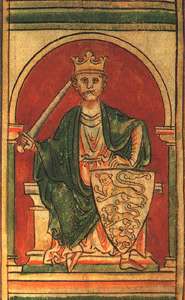
- 1161: In the siege of Ani, Georgian troops take over control of city, only to have it sold for the second time to the Shaddadids, a Kurdish dynasty.
- 1162: Genghis Khan, the founder of the Mongol Empire, is born as Temüjin.
- 1163: The Norwegian Law of Succession takes effect.
- 1168: King Valdemar I of Denmark conquers Arkona on the Island of Rügen, the strongest pagan fortress and temple in northern Europe.
- 1169: On May 1, the Norman invasion of Ireland begins. Richard fitzGilbert de Clare ('Strongbow') makes an alliance with the exiled Irish chief, Dermot MacMurrough, to help him recover his kingdom of Leinster.
- 1170: The Treaty of Sahagún is signed by Alfonso VIII of Castile and Alfonso II of Aragon. Based on the terms of the accord, Alfonso VIII agrees to give Alfonso II three hostages, to be used as tribute payments owed by Ibn Mardanīš of Valencia and Murcia.
- 1170: On December 29, Thomas Becket is murdered in Canterbury Cathedral.
- 1171: Saladin deposes the last Fatimid Caliph Al-'Āḍid and establishes the Ayyubid dynasty.
- 1171: On November 11, Henry II of England lands in Ireland to assert his claim as Lord of Ireland.
- 1174: On July 12, William I of Scotland is captured by the English in the Battle of Alnwick. He accepts the feudal overlordship of the English crown and pays ceremonial allegiance at York.
- 1175: Hōnen Shōnin (Genkū) founds the Jōdo shū (Pure Land) sect of Buddhism.
- 1175: The Treaty of Windsor is signed by King Henry II of England and the High King of Ireland, Ruaidrí Ua Conchobair.
- 1176: On May 29, Frederick Barbarossa's forces are defeated in the Battle of Legnano by the Lombard League which results in the emperor's acknowledgement of the pope's sovereignty over the Papal States and Alexander acknowledging the emperor's overlordship of the imperial Church.
- 1176: On September 17, The Battle of Myriokephalon (Myriocephalum; Turkish: Miryakefalon Savaşı) is fought between the Byzantine Empire and the Seljuk Turks in Phrygia. It is a serious reversal for the Byzantine forces and will be the final, unsuccessful, effort by the Byzantines to recover the interior of Anatolia from the Seljuk Turks.
- 1177: The Treaty or Peace of Venice is signed by the Papacy and its allies, and Frederick I, Holy Roman Emperor. The Norman Kingdom of Sicily also takes part in negotiations and the treaty thereby determines the political course of all Italy for the next several years.
- 1178: Chinese writer Zhou Qufei, a Guangzhou customs officer, writes of an island far west in the Indian Ocean (possibly Madagascar), from where people with skin "as black as lacquer" and with frizzy hair were captured and purchased as slaves by Arab merchants.
- 1179: The Treaty of Cazola (Cazorla) is signed by Alfonso II of Aragon and Alfonso VIII of Castile, dividing Andalusia into separate zones of conquest for the two kingdoms, so that the work of the Reconquista would not be stymied by internecine feuding.
- 1180: The Portuguese Navy defeats a Muslim fleet off the coast of Cape Espichel.
- 1180–1185: the Genpei War in Japan.
- 1182: revolt of the people of Constantinople against the Latins, whom they massacre, proclaiming Andronicus I Comnenus co-emperor.
- 1183: On January 25, the final Peace of Constance between Frederick Barbarossa, the pope, and the Lombard towns is signed, confirming the Peace of Venice of 1177.
- 1183: On September 24, Andronicus I Comnenus has his nephew Alexius II Comnenus strangled.
- 1184: On March 24, Queen Tamar, King of Georgia, accedes to the throne as sole ruler after reigning with her father, George III, for six years.
- 1184: Diet of Pentecost organised by Emperor Frederick I in Mainz
- 1185: The Uprising of Asen and Peter against the Byzantine Empire leads to the restoration of the Bulgarian Empire.
- 1185: Andronicus I Comnenus is deposed and, on September 12, executed as a result of the Norman massacre of the Greeks of Thessalonika.
- 1185: The cathedral school (Katedralskolan) in Lund, Sweden, is founded. The school is the oldest in northern Europe, and one of the oldest in all of Europe.
- 1185: Beginning in this year the Kamakura shogunate deprives the emperor of Japan of political power.
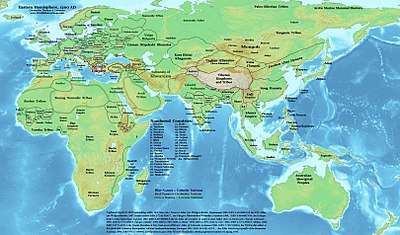
- 1186: On January 27, the future Holy Roman Emperor Henry VI marries Constance of Sicily, the heiress to the Sicilian throne.
- 1187: On July 4, in the Battle of Hattin, Saladin defeats the king of Jerusalem.
- 1187: In August, the Swedish royal and commercial center Sigtuna is attacked by raiders from Karelia, Couronia and/or Estonia.[6]
- 1188: The Riah were introduced into the Habt and south of Tetouan by the Almohad caliph, Abu Yusuf Yaqub al-Mansur, and Jochem and Acem were introduced in Tamesna.[7]
- 1189: On September 3, Richard I is crowned King of England at Westminster.
- 1189: On November 11, William II of Sicily dies and is succeeded by his illegitimate cousin Tancred, Count of Lecce instead of Constance.
- 1189–1192: The Third Crusade is an attempt by European leaders to wrest the Holy Land from Saladin.
- 1190: On June 10, Emperor Frederick Barbarossa drowns in the River Salef, leaving the Crusader army under the command of the rivals Philip II of France and Richard I of England, which ultimately leads to the dissolution of the army.
- 1191: Holy Roman Emperor Henry VI attacked Kingdom of Sicily from May to August but fails and withdraws, with Empress Constance captured (released 1192).
- 1191: On September 7, Saladin is defeated by Richard I of England at the Battle of Arsuf.
- 1192: In April, Isabella I of Jerusalem Christian Queen of Jerusalem
- 1192: In the Battle of Jaffa, King Richard the Lionheart defeats Saladin.
- 1192: In June, the Treaty of Ramla is signed by Saladin and Richard Lionheart. Under the terms of the agreement, Jerusalem will remain under Muslim control. However, the city will be open to Christian pilgrims. The Latin Kingdom is reduced to a coastal strip that extends from Tyre to Jaffa.
- 1192: Minamoto Yoritomo is appointed Sei-i Taishōgun, "barbarian-subduing great general, shōgun for short, the first military dictator to bear this title.
- 1193: Nalanda, the great Indian Buddhist educational centre, is destroyed.
- 1193: Sultan Shahābuddin Muhammad Ghori, establishes the first Muslim empire in India by defeating Prithviraj Chauhan
- 1193: the first known merchant guild is established.
- 1194: Emperor Henry VI conquers Kingdom of Sicily.
- 1195: On June 16, the struggle of Shamqori. Georgian forces annihilate the army of Abu Baqar.
- 1198: The brethren of the Crusader hospital in Acre are raised to a military order of knights, the Teutonic Knights, formally known as the Order of the Knights of the Hospital of St. Mary of the Teutons in Jerusalem.
- 1199: Pope Innocent III writes to Kaloyan, inviting him to unite the Bulgarian Church with the Roman Catholic Church.
Significant people


- Adrian IV, pope
- Aelred, Saint, English monk and spiritual writer
- Afonso Henriques, first king of Portugal
- Alan IV, Duke of Brittany
- Albert of Jerusalem, Saint, Latin Patriarch of Jerusalem
- Albert of Louvain, Saint, Bishop of Liège
- Allama Prabhu, Indian Mystic and an important Vachana Poet.
- Alexander I of Scotland, king
- Alexius I Comnenus, emperor
- Alexius II Comnenus, emperor
- Alexius III Angelus, emperor
- Alfonso II of Aragon, king
- Alfonso VI of Castile, king
- Alfonso VII of Castile, king
- Alfonso VIII of Castile, king
- Amadeus of Lausanne, Blessed, Bishop of Lausanne
- Andrei I Bogolyubsky, Prince of Suzdal
- Andronicus I Comnenus, emperor
- Anselm, Saint, Abbot of Bec and Archbishop of Canterbury
- Anthelm, Saint, Abbot of the Grand Chartreuse
- Arthur I, Duke of Brittany
- Averroes Ibn Rushd, Spanish Islamic polymath
- Baldwin IV of Jerusalem, king
- Basava Indian social reformer, vachana poet
- Béla II of Hungary
- Béla III of Hungary
- Bernard, Saint, Abbot of Clairvaux, preacher and reformer
- Bertha, Duchess of Brittany
- Berthold, Saint, found of the Carmelite Order
- Bhaskara II, Indian mathematician and astronomer
- Bohemund I of Antioch, prince
- Boleslaus III Wrymouth, king of Poland
- Boleslav IV the Curly, high duke of Poland
- Bruno of Segni, Saint, bishop
- Calixtus II, pope
- Canute V of Denmark, king
- Canute VI of Denmark, king
- Chakhrukhadze, Georgian poet
- Christina of Markyate, Prioress of St. Albans Abbey
- Coloman I, King of Hungary
- Conan IV, Duke of Brittany, the Younger
- Conrad I of Montferrat, King elect of Jerusalem
- Constance, Duchess of Brittany
- Constance, Queen of Sicily
- David I of Scotland, king
- David the Builder, King of Georgia
- David V of Georgia
- David Soslani, husband of Queen Tamar
- Demetre I, king of Georgia
- Dominic de Guzmán, Saint, founder of the Order of Preachers
- Edgar of Scotland, king
- Edmund of Abingdon, Saint, theologian, Archbishop of Canterbury
- Eleanor of Aquitaine, queen consort of France and later of the Kingdom of England
- Emeric I of Hungary, king
- Engelbert II of Berg, Saint, Archbishop of Cologne
- Eric I of Denmark, king
- Eric II of Denmark, king
- Eric III of Denmark, king
- Eric IX of Sweden, Saint, king
- Erik Gnupsson, Bishop of Greenland
- Eugene III, Blessed, pope
- Eustathios of Thessalonike, Saint, archbishop of Thessaloniki and writer
- Eystein I of Norway, king
- Eystein II of Norway, king
- Eysteinn Erlendsson, Saint, Bishop of Nidaros
- Felix of Valois, Saint, co-founder of the Order of the Holy Trinity for the Redemption of Captives
- Francis of Assisi, Saint, founder of the Order of Friars Minor
- Frederick Barbarossa, Holy Roman Emperor
- Galdino della Sala, Saint, Archbishop of Milan
- Gelasius II, pope
- Genghis Khan, Great Khan of the Mongol Empire
- Geoffrey II, Duke of Brittany
- Geoffrey V, Count of Anjou and Duke of Normandy
- George III, king of Georgia
- Geza II, king of Hungary
- Gilbert of Sempringham, Saint, founder of the Gilbertines.
- Haakon II of Norway the Broad-shouldered, king
- Harald IV Gille of Norway, king
- Henry (Bishop of Uppsala), Saint
- Henry, Count of Portugal
- Henry I of England, king and Duke of Normandy
- Henry II of England, king and Duke of Normandy
- Henry IV of Germany, king and emperor
- Henry V of Germany, king and emperor
- Henry VI of Germany, king and emperor
- Hildegard of Bingen, Saint, polymath and first Western musical composer known by name
- Hōnen Shōnin (Genkū), religious founder
- Honorius II, pope
- Huemac, last Emperor of the Toltecs, 1090-1170
- Hugh II, Duke of Burgundy
- Hugh III, Duke of Burgundy
- Hugh of Grenoble, Saint, bishop
- Hugh of Lincoln, Saint, bishop
- Huizong, Emperor of China
- Humbert III, Count of Savoy, Blessed
- Hunac Ceel Claimed ruler of The League of Mayapan
- Ida of Boulogne, Saint, countess
- Inge I of Norway Hunchback, king
- Innocent II, pope
- Innocent III, pope
- Isaac II Angelus, emperor
- Ivan Asen I of Bulgaria, emperor
- Ivo of Chartres, Saint, bishop
- Jayavarman VII, Khmer emperor
- John II Comnenos, emperor
- John of England, king and Duke of Normandy
- John of Matha, Saint, co-founder of the Order of the Holy Trinity for the Redemption of Captives
- Kaloyan of Bulgaria, emperor
- Lawrence O'Toole, Saint, Archbishop of Dublin
- Leopold III, Margrave of Austria, Saint
- Lin Tinggui, Chinese painter of Buddhist themes
- Louis VI of France, king
- Louis VII of France, king
- Lucius II, pope
- Magnus Erlendsson, Earl of Orkney, Saint
- Magnus III of Norway, king
- Magnus IV of Norway the Blind, king
- Magnus V of Norway, king
- Maimonides, Jewish philosopher
- Malachy O'More, Saint, Archbishop of Armagh
- Malcolm IV of Scotland, king
- Manuel I Comnenus, emperor
- Matilda of Tuscany, countess
- Mechtildis, Saint, abbess
- Minamoto no Yoritomo, shōgun of Japan, founder of the Kamakura shogunate
- Muhammad of Ghor, Afghan ruler
- Nerses of Lambron, Saint, Archbishop of Tarsus, theologian
- Niels of Denmark, king
- Norbert of Xanten, Saint, founder of the Premonstratensian Order of canons regular, Archbishop of Magdeburg
- Odo I, Duke of Burgundy
- Odo II, Duke of Burgundy
- Odo III, Duke of Burgundy
- Odo of Cambrai, Saint, bishop, theologian
- Olaf Magnusson of Norway, king
- Olegarius, Saint, Archbishop of Tarragona
- Omar Khayyám, Persian poet and astronomer
- Opizars, Beshqen and Beqa, celebrated Georgian gold-smiths.
- Otto of Bamberg, Saint, bishop, chancellor of the Holy Roman Empire
- Paschal II, pope
- Peter Abelard, philosopher
- Peter Nolasco, Saint, co-founder of the Order of Our Lady of Ransom
- Peter, Bishop of Poitiers, Saint
- Peter IV of Bulgaria, emperor
- Philip I of France, king
- Philip II of France, Augustus, king
- Prithviraj Chauhan, king of Ajmer in India
- Raymond of Fitero, Saint, founder of the Order of Calatrava
- Raymond of Peñafort, Saint, canon lawyer
- Richard I of England, king and Duke of Normandy
- Richard of Chichester, Saint, bishop
- Richard of St. Victor, theologian
- Robert Curthose, Duke of Normandy
- Robert de Bethune, Bishop of Hereford
- Roger II of Sicily, king
- Saladin, ruler of Egypt and Syria
- Sancho I of Portugal, king
- Sava, Saint, organizer and liberator of the Serbian Orthodox Church
- Shao Yong, Chinese poet, historian, and philosopher
- Sigurd I of Norway, king
- Sigurd II of Norway, king
- Stefan Nemanja, ruler of Serbia
- Stefan Nemanjić, king of Serbia
- Stephen II, king of Hungary
- Stephen Harding, Saint, abbot, co-founder of the Cistercian Order
- Stephen of England, king and Duke of Normandy
- Suger, Abbot of St.-Denis
- Suryavarman II, Khmer emperor
- Sverker I of Sweden, king
- Sverre of Norway, king
- Sweyn III of Denmark
- Tamar of Georgia, queen
- Thomas Becket, Saint, Archbishop of Canterbury and Chancellor of England
- Urraca of León and Castile queen of Castile, Galicia and León, Empress of All the Spains.
- Valdemar I of Denmark, the Great, king
- Vladimir II Monomakh, prince of Kiev
- Vladislav I Herman of Poland, king
- William I of Scotland, the Lion, king
- William I of Sicily, king
- William Marshal, 1st Earl of Pembroke, knight and statesman
- William of Malmesbury, English historian
- Yue Fei, Chinese general
- Yusuf ibn Tashfin, Almoravid ruler of North Africa and Spain
- Zhang Zeduan, Chinese painter
- Zhou Jichang, Chinese painter
- Zhu Xi, Neo-Confucian Chinese philosopher
- Zhu Yu, Chinese maritime author
References
| Wikimedia Commons has media related to 12th century. |
- Warren 1961, p. 129.
- Warren 1961, p. 159.
- Warren 1961, p. 60-61.
- Le Goff, Jacques (1986). The Birth of Purgatory. Chicago: University of Chicago Press. ISBN 0226470822.
- Soekmono, R, Drs., Pengantar Sejarah Kebudayaan Indonesia 2, 2nd ed. Penerbit Kanisius, Yogyakarta, 1973, 5th reprint edition in 1988 p.57
- Enn Tarvel (2007). Sigtuna hukkumine. Haridus, 2007 (7-8), p 38–41
- Notice sur les Arabes hilaliens. Ismaël Hamet. p. 248.
Bibliography
- Warren, Wilfred Lewis (1961). King John. University of California Press. p. 362. ISBN 9780520036437.CS1 maint: ref=harv (link)